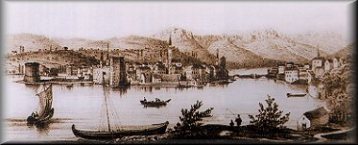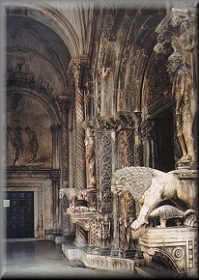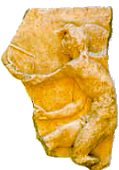 Pliny the Elder, Roman historian, mentions Trogir-Tragurium
in the 1 st century as Roman city, well-know for marble, whereas
Peuntiger’s Table and Antoninus’s Itinerary show Trogir as an important port and
state granary. With fall of the Western Empire, Trogir and other old Roman cities in
Dalmatia became part of a special military province (temat) of the Byzantine Empire. Pliny the Elder, Roman historian, mentions Trogir-Tragurium
in the 1 st century as Roman city, well-know for marble, whereas
Peuntiger’s Table and Antoninus’s Itinerary show Trogir as an important port and
state granary. With fall of the Western Empire, Trogir and other old Roman cities in
Dalmatia became part of a special military province (temat) of the Byzantine Empire.
 In the chaos of the early
Middle Ages, the Roman natives, with no strong Byzantine garisons, lived in fear of
attacks by the barbarian nations, who unprotected, prayed to the new Cristian God. Due to its islet location between the mainland and the island of
Ciovo, the town did not meet the tragic fate of Salona, destroyed during an attack of the
Avars and Slavs. From the seventh century Croatian princes built their castles with the
endowment church of St. Martha, not far from Trogir, in Biaci. Gradually, the Croats enter
the town developing certain Roman-Croatian ethnic symbiosis. After
the great conquests of Carlemagne (?814.), the Dalmatian cities, including Trogir, came
under Frankish rule. The document on the foundation of the Monastery of St. Doimus (1064.)
contains only Croatian national names. Croatian princes and kings after stayed in Trogir
which enjoyed their protection and privileges. After the fall of the Croatian national
dynasty, due to the diplomatic skills of the Bishop Ivan Orsini
(1111.) the citizens of Trogir opened the city gates to the Hungarian king
Koloman who was also crowned the king of Croatia in Biograd na moru. In the chaos of the early
Middle Ages, the Roman natives, with no strong Byzantine garisons, lived in fear of
attacks by the barbarian nations, who unprotected, prayed to the new Cristian God. Due to its islet location between the mainland and the island of
Ciovo, the town did not meet the tragic fate of Salona, destroyed during an attack of the
Avars and Slavs. From the seventh century Croatian princes built their castles with the
endowment church of St. Martha, not far from Trogir, in Biaci. Gradually, the Croats enter
the town developing certain Roman-Croatian ethnic symbiosis. After
the great conquests of Carlemagne (?814.), the Dalmatian cities, including Trogir, came
under Frankish rule. The document on the foundation of the Monastery of St. Doimus (1064.)
contains only Croatian national names. Croatian princes and kings after stayed in Trogir
which enjoyed their protection and privileges. After the fall of the Croatian national
dynasty, due to the diplomatic skills of the Bishop Ivan Orsini
(1111.) the citizens of Trogir opened the city gates to the Hungarian king
Koloman who was also crowned the king of Croatia in Biograd na moru.
 A difficult
period for Trogir was the invasion of the Mongolians in pursuit of the Hungarian-Croatian
king Bela IV who in 1242. rescued himself by escape to the safer Trogir. There he had an
opportunity to admire recently finished portal of Master Radovan,
the masterpiece of Middle Age Croatian Art. A difficult
period for Trogir was the invasion of the Mongolians in pursuit of the Hungarian-Croatian
king Bela IV who in 1242. rescued himself by escape to the safer Trogir. There he had an
opportunity to admire recently finished portal of Master Radovan,
the masterpiece of Middle Age Croatian Art.
 In the
Middle Ages the town was ruled by the Statute (the oldest preserved one from 1322.).
Members of the Great Council were elected from the Small Council and the Secret Souncil,
which discussed the important security issues of the city. A pharmacy
in Trogir is mentioned already in 1271., as the first one in this part of
Europe. It shows the level of economic civilizational achievments of the
free Middle Ages Comune with widespread. commercial and cultural relationships troughout
the Mediterranean and Europe. In June 1420., after a bloody battle, the Venetian troops of
Captain Petar Loredano entered Trogir. All the city’s liberties were abolished, and Venice
took all the power which lasted till the end of the 18th century. After the
brotherhoods were dissolved, the citizens united in citizens’ assemblies through
which they tried to restrain the despotism of the governer and nobles. In the
Middle Ages the town was ruled by the Statute (the oldest preserved one from 1322.).
Members of the Great Council were elected from the Small Council and the Secret Souncil,
which discussed the important security issues of the city. A pharmacy
in Trogir is mentioned already in 1271., as the first one in this part of
Europe. It shows the level of economic civilizational achievments of the
free Middle Ages Comune with widespread. commercial and cultural relationships troughout
the Mediterranean and Europe. In June 1420., after a bloody battle, the Venetian troops of
Captain Petar Loredano entered Trogir. All the city’s liberties were abolished, and Venice
took all the power which lasted till the end of the 18th century. After the
brotherhoods were dissolved, the citizens united in citizens’ assemblies through
which they tried to restrain the despotism of the governer and nobles.
 Many
distinguished inhabitants of Trogir fled from their city. Among them was Petar Berislavic, later Viceroy (Ban) of Croatia
and Bishop of Zagreb, who died by a Turkish sword in 1520., deceived and exausted by
heavy fighting for the freedom of Croatia. The majority of nobles studied in
Italian cities where they got humanistic education. Among
them was Ivan Lucius-Lucic, the father of modern Croatian
historiography. Many
distinguished inhabitants of Trogir fled from their city. Among them was Petar Berislavic, later Viceroy (Ban) of Croatia
and Bishop of Zagreb, who died by a Turkish sword in 1520., deceived and exausted by
heavy fighting for the freedom of Croatia. The majority of nobles studied in
Italian cities where they got humanistic education. Among
them was Ivan Lucius-Lucic, the father of modern Croatian
historiography.
 Turkish
devastation in the near of Trogir from the 17 th century completely destroyed
the town from the economic point of view. At the end of the 18 th century Venetian
Republic was abolished. During Napoleon’s wars from 1806-1814., Trogir
was annexed to the Illyrian provinces under Marshal Marmont. After Napoleon’s
military defeat Trogir became the part of Austria-Hungary. In 1867., with the support of Bishop
Strossmayer, the National Library was founded and
became the focal point of national renaissance. Twenty years later, after long political
struggles with Italy-oriented population demanding autonomy, the commune of Trogir passed
into Croatian hands. With the fall of the Austrian Empire after the World War I in 1918.,
Trogir joins Kingdom of Serbs, Croats and Slovenians. General dissatisfaction and
stagnation was gradually increasing. In April 1941., Italy occupies Trogir without
resistance and in 1943., one-year German occupation of Trogir begins. Trogir gained its
freedom in the end of 1944., after numerous victims and destroyed economy. The period of
economical development, particulary shipbuilding and turism, follows, together with the
increase of life standard of the citizens. But, the narrowness of the national awareness
and democratic freedoms in South-Slavic Federation causes a great discontent of the
citizens. Turkish
devastation in the near of Trogir from the 17 th century completely destroyed
the town from the economic point of view. At the end of the 18 th century Venetian
Republic was abolished. During Napoleon’s wars from 1806-1814., Trogir
was annexed to the Illyrian provinces under Marshal Marmont. After Napoleon’s
military defeat Trogir became the part of Austria-Hungary. In 1867., with the support of Bishop
Strossmayer, the National Library was founded and
became the focal point of national renaissance. Twenty years later, after long political
struggles with Italy-oriented population demanding autonomy, the commune of Trogir passed
into Croatian hands. With the fall of the Austrian Empire after the World War I in 1918.,
Trogir joins Kingdom of Serbs, Croats and Slovenians. General dissatisfaction and
stagnation was gradually increasing. In April 1941., Italy occupies Trogir without
resistance and in 1943., one-year German occupation of Trogir begins. Trogir gained its
freedom in the end of 1944., after numerous victims and destroyed economy. The period of
economical development, particulary shipbuilding and turism, follows, together with the
increase of life standard of the citizens. But, the narrowness of the national awareness
and democratic freedoms in South-Slavic Federation causes a great discontent of the
citizens.
 After the
first democratic elections, held in 1990. by general plebiscitery of the Croatian for free
and independent state of Croatia, Trogir gives new victims as
the foundation of the freeedom of the Croatian people and the involvement of Croatia in
European civilizational and economic prosperity. After the
first democratic elections, held in 1990. by general plebiscitery of the Croatian for free
and independent state of Croatia, Trogir gives new victims as
the foundation of the freeedom of the Croatian people and the involvement of Croatia in
European civilizational and economic prosperity.
HISTORICAL AND CULTURAL MONUMENTS AND FAMOUS WORKS OF ART
 The old
town core has been formed between the 13 th and 15 th century inside defence wall that was
restored by Venice in the 15 th century. They also added two forts that are still
preserved: citadel Kamerlengo, and the tower of St. Mark. The Kamerlengo
citadel, that is used to be connected with the city walls, is on the south-western part of
the island. Its present shape it got in the 15th century. More in the south is the tower
of St. Mark from the 15th century, and between the tower and the citadel, there is a
gloriet built in the style of classicism, from the time of the French occupation. In the
part of the town that developed on Ciovo there are a few interesting small churches. The
older, eastern part of the town has developed around the main square with the cathedral.
The western part, Pasika, was built later. In the past, the town was one of the cultural
centres of Dalmatia: in the 13 th century master Radovan worked there, and in the
15 th century there were famous sculptors, architects, builders, humanists and historians
(Ivan Lucius). The Radovan Portal finished in 1240, is a
monumental and perhaps unique work of this great Croatian artist, of whom the inscription
on the base of the lunette says he is "the best of all in this artisanship". The old
town core has been formed between the 13 th and 15 th century inside defence wall that was
restored by Venice in the 15 th century. They also added two forts that are still
preserved: citadel Kamerlengo, and the tower of St. Mark. The Kamerlengo
citadel, that is used to be connected with the city walls, is on the south-western part of
the island. Its present shape it got in the 15th century. More in the south is the tower
of St. Mark from the 15th century, and between the tower and the citadel, there is a
gloriet built in the style of classicism, from the time of the French occupation. In the
part of the town that developed on Ciovo there are a few interesting small churches. The
older, eastern part of the town has developed around the main square with the cathedral.
The western part, Pasika, was built later. In the past, the town was one of the cultural
centres of Dalmatia: in the 13 th century master Radovan worked there, and in the
15 th century there were famous sculptors, architects, builders, humanists and historians
(Ivan Lucius). The Radovan Portal finished in 1240, is a
monumental and perhaps unique work of this great Croatian artist, of whom the inscription
on the base of the lunette says he is "the best of all in this artisanship". |
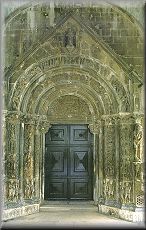
|
 The
entrance into the town from the north is through the renaissance town gates from the 17 th
century with the sculpture of Blessed Ivan Ursini, the patron saint of the town. On the
main square there is the cathedral from the 13 th - 15 th century with characteristics of
both Romanesque and Gothic styles. The most important port of the cathedral, and the most
valuable work of the Romanesque sculpture in Dalmatia is the portal of master Radovan from
1240. The sculpture of St. Lovro and triangular gable were added to it in the 14 th
century. In the cathedral there are also: the baptistery from 1464, the most
important preserved work of the sculptor Andrija Alesi; octagonal stone pulpit
from the 13 th century; Gothic chorus benches; ciborium from the 14 th
century; paintings of the local and Italian masters; Gothic chapel of St. Jeronim
from 1438; and chapel of the Blessed Ivan Ursini, the most beautiful renaissance
monument in Dalmatia, the work of Nikola Firentinac from the 15 th century. The
entrance into the town from the north is through the renaissance town gates from the 17 th
century with the sculpture of Blessed Ivan Ursini, the patron saint of the town. On the
main square there is the cathedral from the 13 th - 15 th century with characteristics of
both Romanesque and Gothic styles. The most important port of the cathedral, and the most
valuable work of the Romanesque sculpture in Dalmatia is the portal of master Radovan from
1240. The sculpture of St. Lovro and triangular gable were added to it in the 14 th
century. In the cathedral there are also: the baptistery from 1464, the most
important preserved work of the sculptor Andrija Alesi; octagonal stone pulpit
from the 13 th century; Gothic chorus benches; ciborium from the 14 th
century; paintings of the local and Italian masters; Gothic chapel of St. Jeronim
from 1438; and chapel of the Blessed Ivan Ursini, the most beautiful renaissance
monument in Dalmatia, the work of Nikola Firentinac from the 15 th century.
The most beautiful objects from the treasury are embroideries, ivory Gothic triptych, and
medieval illuminated codices.
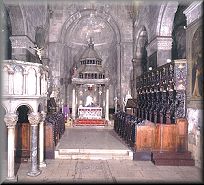
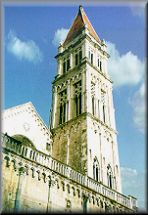 
 On the
square there is the town loggia from the 15 th century, clock tower, and the small church
of St. Sebastijan that was built in the renaissance style. The small, early medieval
church of St. Barbara, from the 9 th - 10 th century, is located behind the loggia and
it is the oldest church in Trogir. The square is closed by the Cipiko Palace. Opposite to
it, is the town hall from the 15 th century. The renaissance church of the St. John the
Baptist from the 13 th century, with remains of the medieval frescos and the tomb of the
Cipiko family, is on the coast. Further down the coast is part of preserved defence walls
with tower and renaissance town gates from 1593. On the
square there is the town loggia from the 15 th century, clock tower, and the small church
of St. Sebastijan that was built in the renaissance style. The small, early medieval
church of St. Barbara, from the 9 th - 10 th century, is located behind the loggia and
it is the oldest church in Trogir. The square is closed by the Cipiko Palace. Opposite to
it, is the town hall from the 15 th century. The renaissance church of the St. John the
Baptist from the 13 th century, with remains of the medieval frescos and the tomb of the
Cipiko family, is on the coast. Further down the coast is part of preserved defence walls
with tower and renaissance town gates from 1593.
Other interesting historical and cultural monuments:
|
